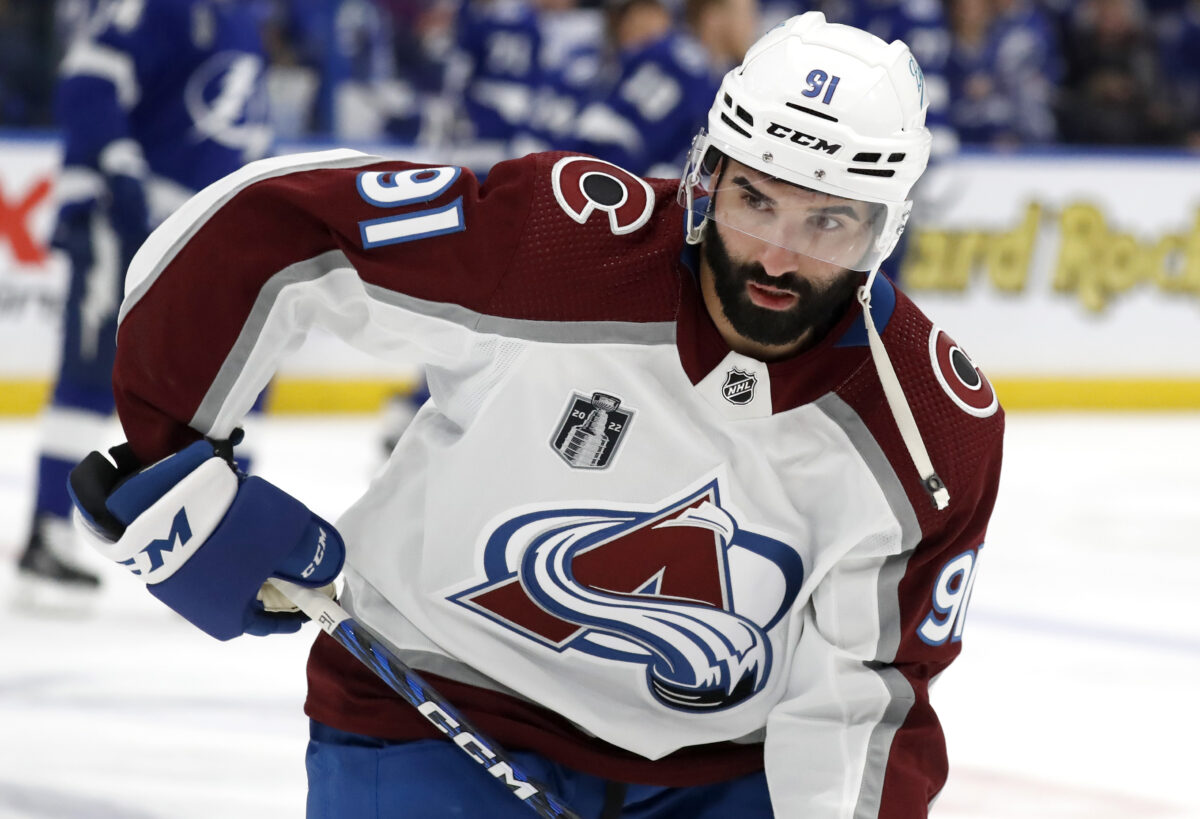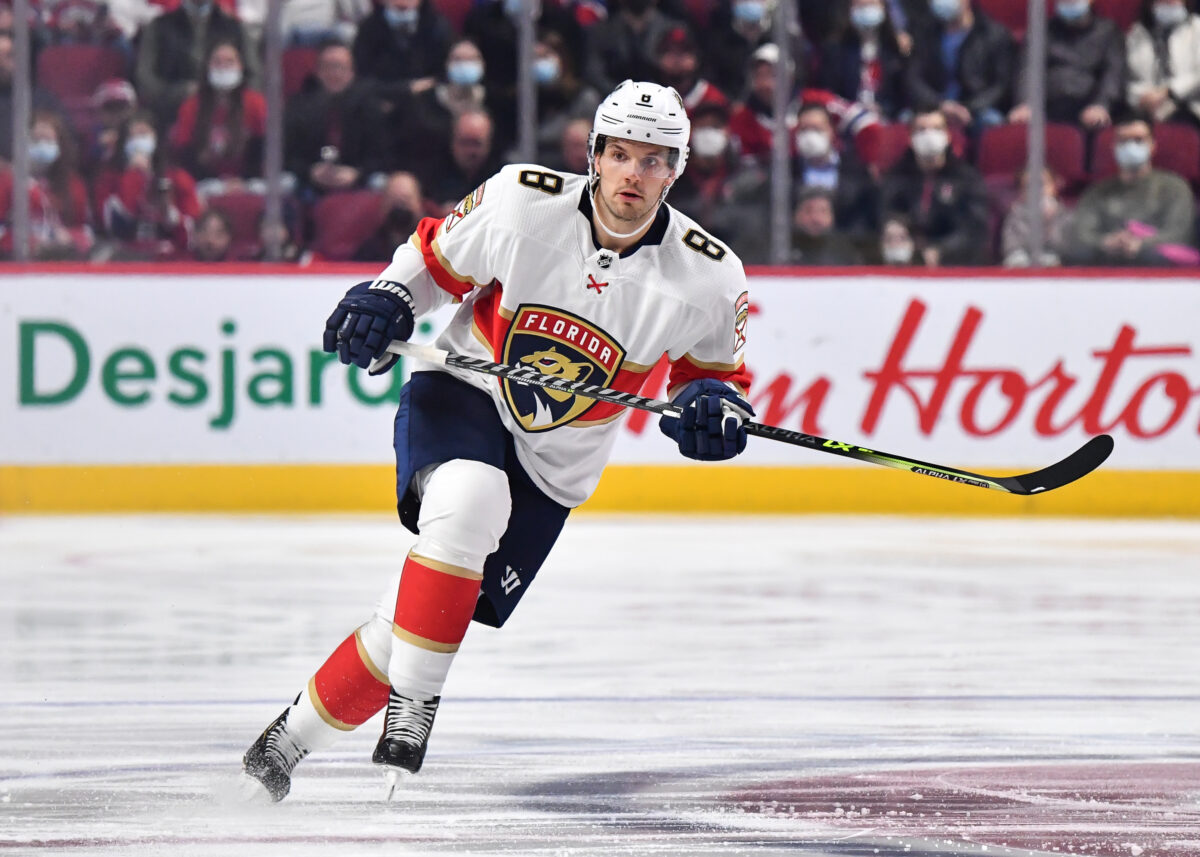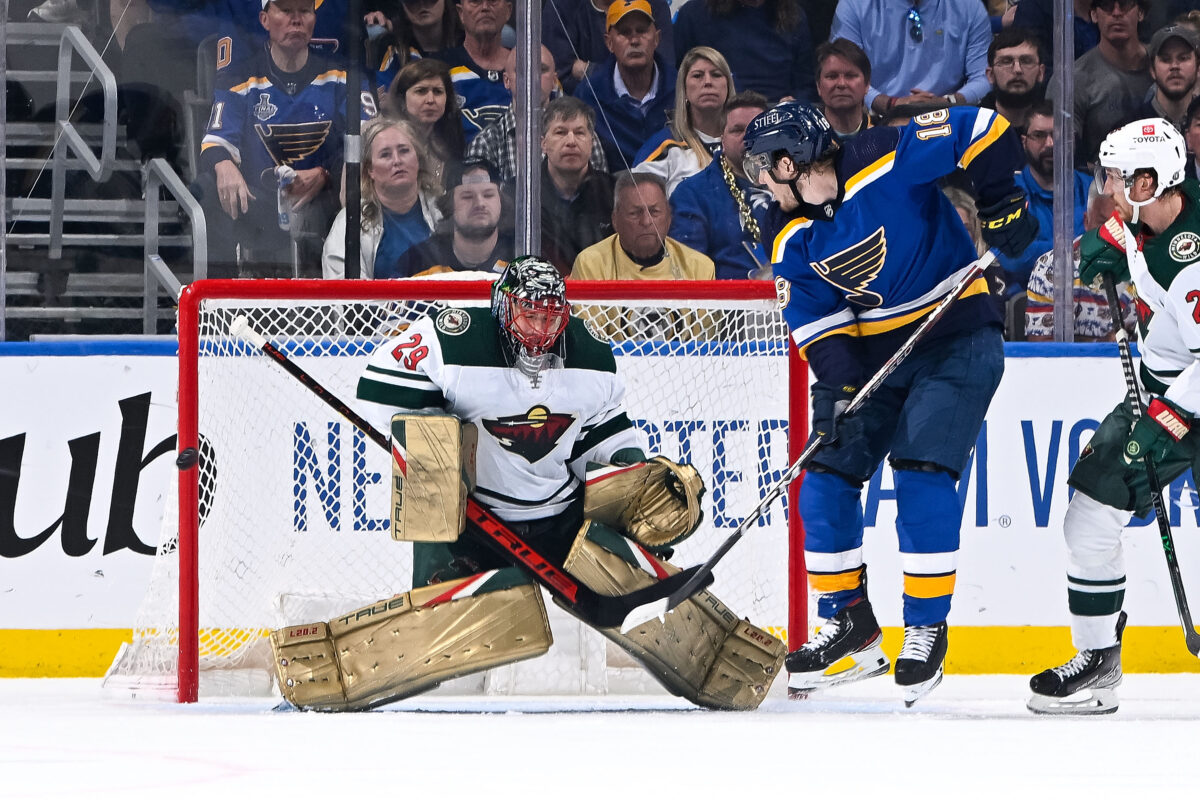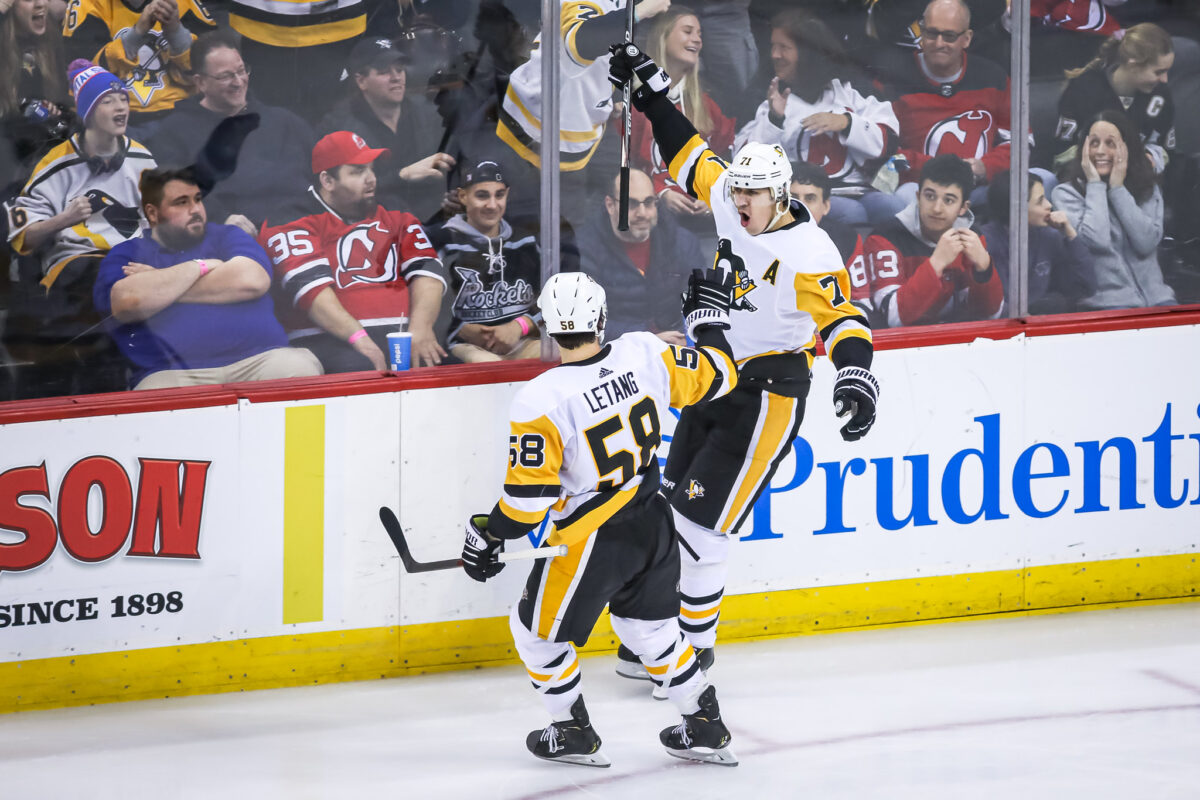With just over a week to go before the official opening of NHL Free Agency, there is no better time to discuss one of the most iconic pairings known to man: general managers and massive free-agent contracts. The league’s history is littered with missteps, with executives handing out deals based on physical traits, overperformances across small sample sizes, or reputations long past due. Many such candidates can be found within the 2022 free-agent class, making it a near certainty that someone inks a deal they eventually regret, whether it sets in immediately or a few years down the line. Now, let’s dig into five of the biggest potential busts of 2022 NHL Free Agency.
Nazem Kadri, Colorado Avalanche
As is the case with a number of players on this list, the contract term is the most significant factor in determining whether or not a deal is labelled as a bust. Players – even older ones – on shorter deals are much more likely to provide positive value over the course of the agreement. In these cases, the age-related decline can mostly be avoided, and players who underperform are off of a team’s salary books within a few years. Locking anyone up to long-term pacts significantly reduces a team’s margin for error, making navigating the free-agent period quite the endeavour.
Related: Top 25 Free Agents of 2022
That brings us to the first candidate for an unsavoury deal on the open market: Nazem Kadri. The 31-year-old center (who turns 32 before the 2022-23 season) is coming off of the most productive campaign of his NHL career, setting personal bests in almost every offensive category. He produced a 29-goal, 87-point season and was named an All-Star for the first time, all the while playing on a 6-year, $27 million contract. Then, tack on an impressive playoff performance in which the Stanley Cup winner tallied 15 points in 16 games, and scored a memorable overtime-winner in the Cup Final. Regardless of which sweater he pulls on next season, he is sure to receive a healthy raise on the last contract’s $4.5 million average annual value (AAV).

While his new team likely envisions him as part of their top powerplay unit, they cannot offer a supporting cast of the Avalanche’s calibre, shackling him with more of the playmaking and play-driving responsibilities. There is no question that Kadri is a superb secondary option, but it remains to be seen whether he can deliver as the primary focal point and if his improved maturity continues. Is there enough to warrant an expensive, multi-year deal which could take the 13-year-veteran into his late-30s? Given general manager Joe Sakic’s negotiation history, it’s unlikely he receives such an offer from the Avalanche.
Ben Chiarot, Florida Panthers
Defensemen Ben Chiarot received a huge reputation boost for his role in the Montreal Canadiens’ unlikely run to the 2021 Stanley Cup Final, seemingly signaling that teams need a big bruising blueliner to achieve success in the postseason. What followed was a horrible season for Chiarot and the Canadiens, where injuries and significant departures led to the third-worst regular-season campaign (by points percentage) in franchise history.
The 31-year-old posted atrocious shot and scoring chance numbers, with the Canadiens accounting for only 44.5% and 43.1% respectively of the on-ice totals at 5v5 with Chiarot manning the blue line. It wasn’t just a byproduct of Montreal’s quality, as his relative numbers (on vs off-ice results) were among the worst on the team, and have consistently been in the negative over his NHL tenure. Although his numbers jumped after joining the Florida Panthers, they still lagged behind the rest of the roster. The Panthers controlled less than a 50% share of shots (SF%), scoring chances (SCF%), and chance quality (xGF%) with him on the ice during the playoffs, while hovering near 55% as a whole.

Perhaps more damning than his possession numbers is his penalty differential. Over the past three seasons, only Ian Cole owns a worse taken-drawn differential than Chiarot’s ugly minus-48 tally. He is a massive liability who puts his teams in shorthanded situations far too often. Unless his employer has a strong penalty kill or impenetrable goaltender, that is too much unnecessary risk to carry on one’s blue line, and something that could only get worse with age.
Related: The 5 Most Disappointing Players of the 2022 Stanley Cup Playoffs
An older, physical rearguard with limited mobility who takes a lot of penalties is the exact opposite kind of defenseman thriving in the modern NHL. Still, the price that the Panthers paid to acquire him at the trade deadline (prospect Ty Smilanic and a first- and fourth-round draft pick) suggests his value is still relatively high around the league. It’s easy to see a team fall in love with his intangibles and give him a raise on the $3.5 million he made last season. Given his trajectory and already fleeting foot speed, that could end up being one of the most regrettable deals handed out this offseason.
Evander Kane, Edmonton Oilers
There might not be a more fascinating case in the upcoming free-agent period than Evander Kane, most recently of the Edmonton Oilers. First, is his pending grievance hearing which could render any contractual agreements null and void should he be deemed the property of the San Jose Sharks, despite having played for the Oilers for the better part of the season and the entirety of the playoffs. Second, is the fact that the controversial winger was stapled to Connor McDavid’s wing upon joining the team. Unsurprisingly, he found immediate success and tallied 35 goals in 58 combined regular season and playoff games representing a 50-goal pace over an 82-game schedule.
You may also like:
- Oilers News & Rumors: Hyman, Kane, McDavid, Bouchard
- NHL Projected Lineups, Starting Goalies, Injuries, Updates
- Blue Jackets News & Notes: Voronkov, Costly Mistakes & More
- Carter Yakemchuk – 2024 NHL Draft Prospect Profile
- Unpacking the Nashville Predators’ 18-Game Point Streak
Any interested parties have to weigh the benefits of Kane’s on-ice play against his many off-ice issues and decide whether he can stay out of trouble for the duration of his contract. The 30-year-old forward scored at a 32-goal pace over his last three seasons with the Sharks, which should assuage fears that his production isn’t just a byproduct of playing with McDavid. Even so, he is on the downswing of his career and could command a deal that takes him through his gradual decline as he approaches his mid-to-late-30s. Playoff hot streaks consistently entice general managers to make massive commitments without fully considering the future ramifications on the cap or the natural progression of the player.
Regardless of your opinion on Kane, everything surrounding his situation should give executives pause. His age and performance in a small, high-profile sample of games make him a candidate ripe for an excessive overpayment.
Marc-Andre Fleury, Minnesota Wild
First, goalies are voodoo, and predicting how any of them – barring an extremely select few – will perform year-to-year is a dicey exercise. Throw in advanced age and any rational prognosticating can go out the window. Given his reputation, 37-year-old Marc-Andre Fleury promises to be the belle of the 2022 free agent goalie ball and could be in line for a multi-year deal in spite of his recent shortcomings. Despite winning the Vezina Trophy as recently as the 2020-21 season, he has been one of the NHL’s worst goaltenders over the past three seasons when adjusting for the quality of his workload.

Among goalies with at least 41 appearances since 2019-20, Fleury ranks 28th in save percentage (SV%) with a mark of .912, and 32nd in goals saved above expected (GSAx). Those numbers on their own are more typical of a fringe starter, and look even worse when isolating the 2021-22 campaign where he posted a .908 SV% (20th – minimum 10 games) and a minus-11 GSAx (41st) over 56 games split between the Chicago Blackhawks and Minnesota Wild. Further, he underwhelmed in the postseason with a .906 SV% and a minus-1.58 GSAx as the Wild were booted by the St. Louis Blues. Motivation could certainly be a factor in his underperformance, but that conveniently ignores the trend of decline.
As I mentioned off the top, contract risk can be mitigated by cutting down on the term of a deal. If Fleury is awful from the outset, a one-year contract takes him off the books after only one season. A multi-year commitment means teams must either operate around his decline or give up assets to entice other organizations to take on his deal. Given the scarcity of this offseason’s goalie market, Fleury receiving a poison-pill deal from any number of desperate suitors would not come as a surprise.
Evgeni Malkin, Pittsburgh Penguins
Like Fleury before him, Evgeni Malkin‘s age (he turns 36 at the start of the 2022-23 season) and his spotty injury history as of late makes his next move baked in uncertainty. The Penguins’ upper brass are playing hardball with the franchise legend in hopes of minimizing their risk towards the end of the Sidney Crosby era.
The Russian pivot ranks 18th in points per game (P/G) since 2019-20 but has only appeared in 129 of the Penguins’ 207 regular-season games over that time. Further, he only ranks 76th in points per 60 minutes at 5v5 since 2020-21. The skill is still present, but his physical decline is readily apparent and he’s become an increasing liability at even strength. Talent and reputation represent only one side of the equation, availability is just as much – if not more – of a factor at the negotiation table.

Most of Malkin’s rumoured destinations don’t have a two-way center of Crosby’s calibre to insulate his defensive deficiencies at this stage of his career, thrusting him into more of a primary role in the lineup. The name recognition alone is sure to guarantee him a hefty contract next season, whether it’s in Pittsburgh or not. Whether he can regularly deliver an appropriate return on investment is a different story altogether. How long until the wheels fall off completely and his new team’s owners are left holding the bag? Like most of the names on this list, the term will be key.
2022 NHL Free Agency Full of Potential Landmines
The offseason, and the free-agent period, in particular, is a time when management groups can separate themselves from their peers, for better or for worse. Some executives can get caught up in bidding wars around the class’s big fish, while others are content scouring the bargain bin for cost-effective options. Some deals are disasters the minute pen is put to paper, while others need to marinate before a verdict is delivered. Regardless, free agency is consistently the most entertaining time of the year, and the 2022 edition should be no exception.
Dishonourable Mentions: Josh Manson (Anaheim Ducks); Reilly Smith (Vegas Golden Knights); Darcy Kuemper (Colorado Avalanche); Ville Husso (St. Louis Blues); Mason Marchment (Florida Panthers)
Data courtesy of All Three Zones, Evolving Hockey, Hockey Reference, MoneyPuck, and Natural Stat Trick.